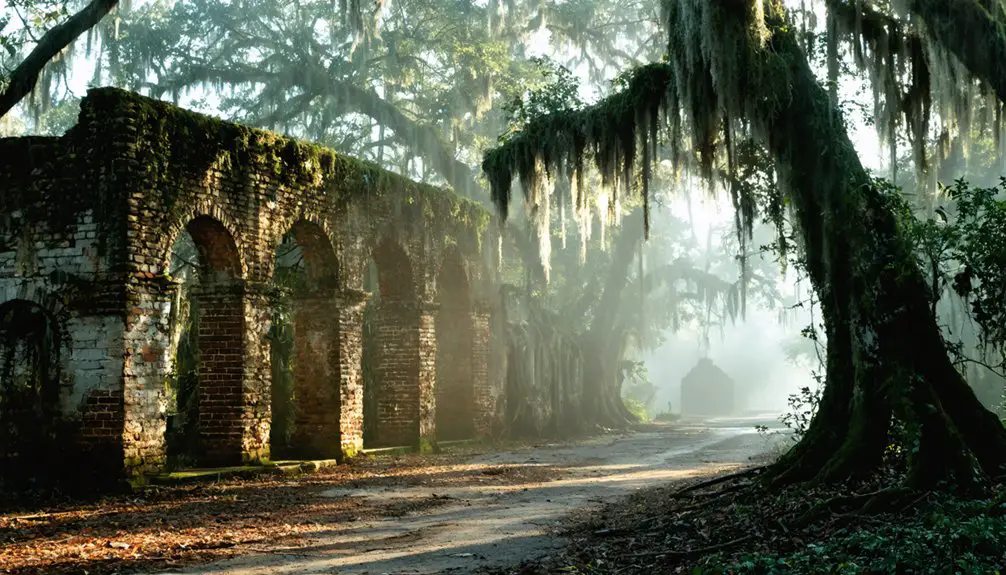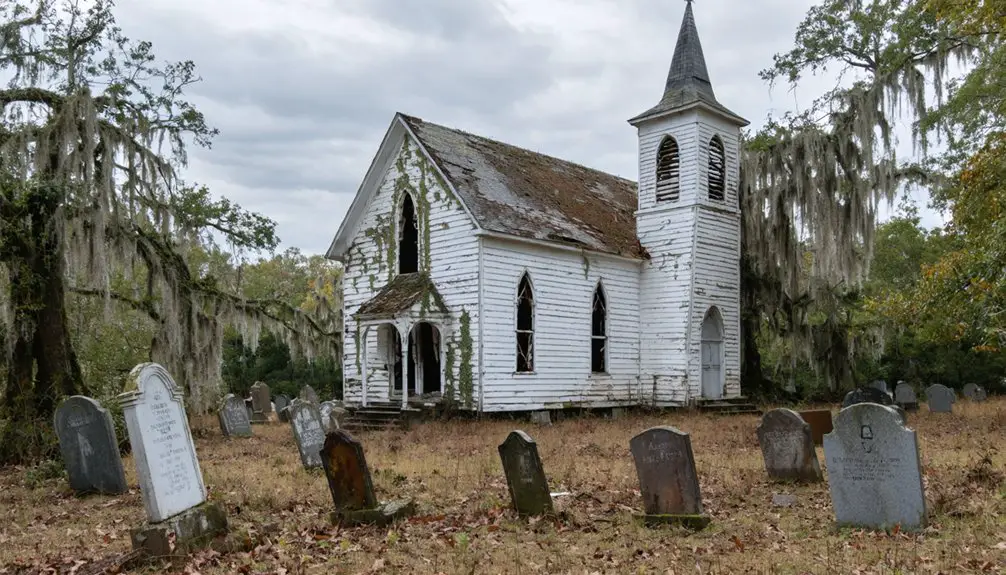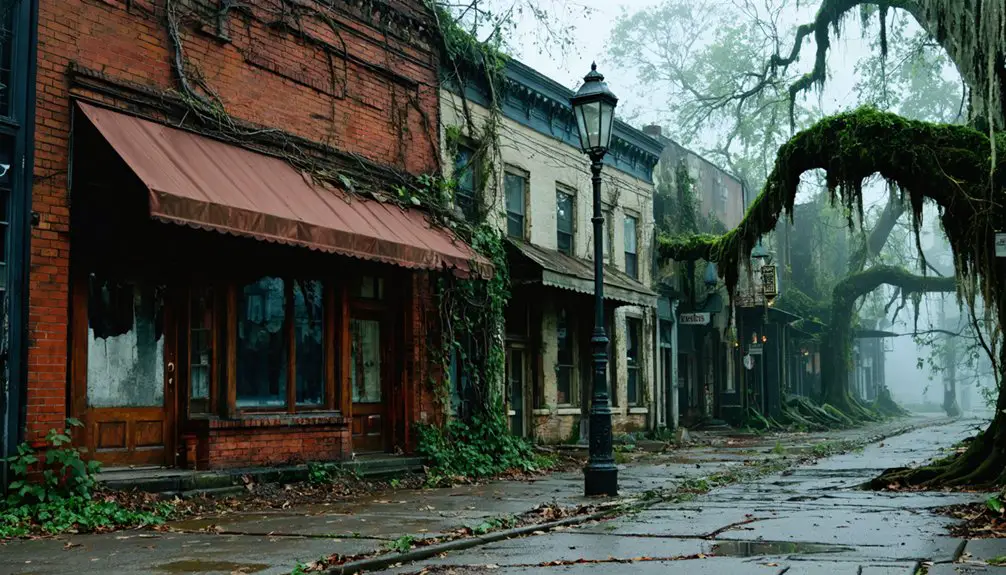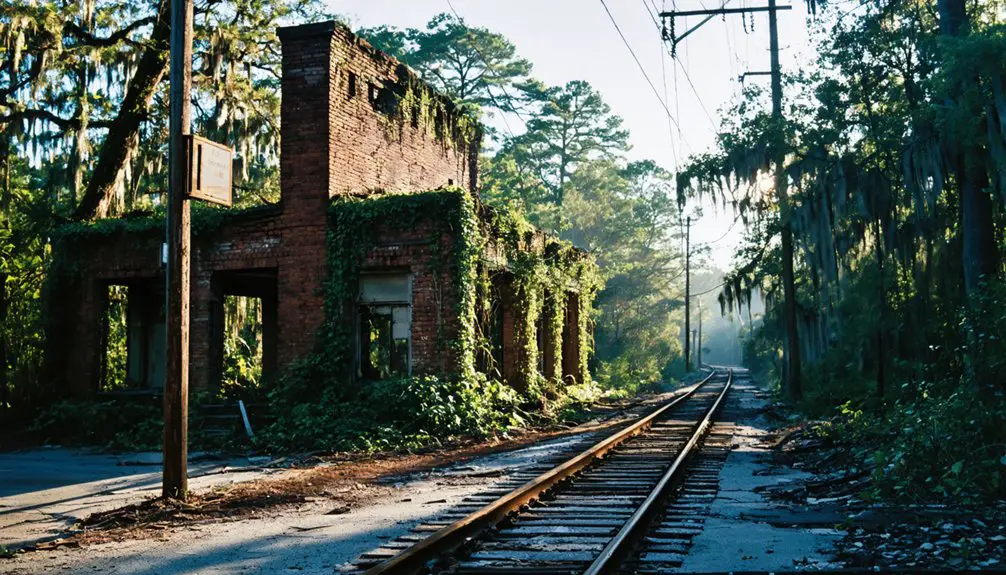You’ll find the ruins of Dorchester, South Carolina along the Ashley River, where Congregationalists from Massachusetts established a thriving colonial settlement in 1696. The town flourished as a military stronghold and trading center, complete with Fort Dorchester and St. George’s Church, before declining in the late 1700s as residents moved to Georgia. Today, the Colonial Dorchester State Historic Site preserves these remarkable brick and tabby remains, where each stone tells a tale of early American ambition.
Key Takeaways
- Dorchester transformed from a thriving colonial trading center into a ghost town by 1788 when most residents relocated to Georgia.
- Economic decline began in the 1750s as self-sufficient plantations reduced the need for Dorchester’s marketplace.
- The American Revolution caused significant damage to the town’s infrastructure, accelerating its abandonment.
- Today, only ruins remain, including St. George’s Anglican Church bell tower and the tabby fort at Colonial Dorchester State Historic Site.
- Archaeological excavations continue at the site, preserving artifacts and historical evidence of the former colonial settlement.
The Birth of a Colonial Settlement
When the Earl of Shaftesbury granted 1,800 acres of land to John Smith in 1676, he laid the foundation for what would become the colonial settlement of Dorchester.
After Smith’s death in 1682, the land reverted to the state, setting the stage for a new chapter in colonial governance.
Smith’s passing marked a pivotal moment, as his land’s return to state control reshaped the colony’s administrative future.
You’ll find that in 1696, a group of determined Congregationalists from Dorchester, Massachusetts, led by Reverend Joseph Lord, acquired 4,050 acres including Smith’s original tract. The settlers were motivated by severe land shortages in their New England hometown.
Despite settlement challenges, they quickly established themselves between the Ashley River and Dorchester Creek.
They built a fort using tabby and constructed St. George’s Church, transforming the wilderness into a thriving religious and trading center.
The proprietors’ strategy of welcoming non-Anglican settlers helped create a diverse community that stood as a counterweight to the region’s dominant Anglican influence.
The settlement’s strategic location enabled flourishing trade with Native Americans and established Dorchester as an important commercial hub.
Religious Roots and Early Community Life
You’ll find that Dorchester’s origins are deeply rooted in Congregationalist missionary efforts, as Reverend Joseph Lord led Massachusetts Puritans to establish a religious settlement in Carolina in 1696.
The community’s spiritual and social life centered around their meeting house, which served as both church and gathering space for the growing population of Protestant dissenters. The settlers initially divided their new land by drawing lots in March 1697.
Under Lord’s leadership, the Congregationalist church became the cornerstone of early Dorchester life, fostering a tradition of religious tolerance that attracted Quakers, Presbyterians, and Huguenots to the settlement. By 1770, the thriving town had grown to include a church and library, showcasing its commitment to both faith and education.
Congregationalist Mission to Carolina
Founded in 1696 by a determined group of Congregationalists from Dorchester, Massachusetts, the Carolina mission marked a significant religious venture into the Southeast’s colonial frontier. Their missionary work established a Reformed Protestant community that thrived under Carolina’s religious tolerance policies, which allowed any group of seven or more to form their own church.
You’ll find that these early settlers brought with them:
- New England Puritan traditions of self-governance and covenantal church structure
- Strong emphasis on education and scripture study
- Commitment to maintaining distinct theological identity
- Focus on building a close-knit community bound by shared faith
Within Carolina’s multicultural landscape, the Congregationalists coexisted with French Huguenots and other Protestant denominations while preserving their unique religious practices and social regulations. Like other religious groups in the region, they faced challenges including mob violence that would later affect various faiths in the area. Following similar patterns of early religious development in the Carolinas, the area would later see the establishment of the Bethel church in 1881 as the first Seventh-day Adventist congregation in Valle Crucis.
Their influence helped establish Dorchester as a regional religious center, shaping its development through Puritan ideals and communal values.
Meeting House’s Central Role
At the heart of early Dorchester’s religious and civic life stood the Meeting House, first constructed as a wooden structure in 1696 before being replaced by a larger brick building known as the White Meeting House in 1700.
The Meeting House’s significance extended far beyond religious services. You’ll find it served as the epicenter of community gatherings, where settlers managed church affairs, disciplined members, and made essential governance decisions through the Board of Select Men. The congregation remained under the steadfast leadership of Reverend John Osgood until his death nearly two decades after their arrival.
The building anchored the town’s carefully planned 50-acre grid layout, reflecting the settlers’ New England heritage. While the brick structure burned during the Revolution in 1781 and was rebuilt in 1794, the ruins you see today – reaching 9 feet high in places – stand as evidence of this critical center of early colonial life. The structure was founded by a group of determined Congregationalists from Dorchester who established their new settlement in December 1695.
Religious Leadership and Community
When Puritan settlers established Dorchester in 1695, they brought with them a distinct religious vision led by Reverend Joseph Lord, their newly ordained minister from Massachusetts.
Under his religious leadership, the community flourished around Congregationalist principles that emphasized both spiritual guidance and civic organization. The settlement’s connection to their religious roots began with the original Puritan migration in 1630, when the first settlers landed in Matapan, Massachusetts.
- The Congregational church served as the heart of town life, shaping social interactions and governance.
- Religious leaders maintained strong ties with Massachusetts churches, preserving their cultural identity.
- Ministers acted as both spiritual guides and community organizers, facilitating town development.
- Regular church activities fostered community cohesion in a largely Anglican colonial environment.
You’ll find that this religious foundation defined Dorchester’s early years until the mid-18th century, when health concerns and limited land prompted many congregants and their minister to relocate to Georgia.
Military Significance During the Revolution
During the American Revolution, Fort Dorchester emerged as an essential military stronghold that helped shape the outcome of the war in South Carolina’s Lowcountry.
You’ll find that the fort’s military strategies centered on controlling the Ashley River, which proved significant for supply lines and regional dominance.
Beginning as a brick powder magazine in 1757, the fortifications history took a dramatic turn when Patriot forces under Capt. Francis Marion garrisoned it in 1775.
From humble beginnings as a powder magazine, Fort Dorchester transformed into a vital Patriot stronghold under Marion’s command.
While the British seized control in 1780, they couldn’t hold it for long. In December 1781, Col. Wade Hampton and Gen. Nathanael Greene reclaimed the fort, marking a pivotal shift in the war. Major Doyles ordered the destruction of stores and artillery before retreating from the fort.
The site also served as an important hospital camp following the Battle of Eutaw Springs, treating over 600 wounded soldiers from both sides.
Rise to Regional Prominence

You’ll find Dorchester’s rise to regional prominence was largely due to its strategic position on the Ashley River, where boats with drafts under six feet could easily navigate between the settlement and Charleston.
By 1770, the town had flourished into a bustling hub of about 40 homes, complete with a school, library, and monthly fair, while serving as an essential trade center for surrounding plantations.
Dorchester’s economic significance was further enhanced by its military importance, featuring two wharves, a boat-building facility, and a fort that would later prove critical during the Revolutionary War.
Strategic River Location
The strategic location of Dorchester along the Ashley River, 18 miles inland from Charleston, propelled the settlement’s rise to regional prominence in colonial South Carolina.
You’ll find this prime location at the confluence of Dorchester Creek and Eagle’s Creek, where river navigation supported the town’s growth as an essential trade hub.
- Natural waterways allowed vessels with 6-foot drafts to transport goods between Dorchester and Charleston
- The river bend’s position created an ideal defensive point for protecting inland South Carolina
- Strategic placement enabled control of significant trade routes connecting inland communities
- River access supported extensive commerce in rice, deer skins, and other agricultural products
The settlement’s founders chose this location wisely, establishing Dorchester as a key military depot and commercial center that would dominate regional trade for nearly a century.
Population and Economic Growth
Over twelve decades of growth transformed Dorchester from a modest community of 16,294 residents in 1900 into a thriving regional hub with 161,540 inhabitants by 2020.
You’ll find the most dramatic population dynamics occurred between 1970-1980, when the community surged by 82.1%, followed by another significant jump of 41.4% in the following decade.
Today’s economic indicators reveal a prosperous community with a median household income of $76,896 and a robust 75.4% homeownership rate.
The region’s transformation from agricultural roots to a diversified economy has attracted a steady influx of residents, with current growth continuing at 1.35% annually.
The county’s strategic position near Berkeley and Charleston, combined with strong employment figures and a low 3.5% unemployment rate, has cemented its position as a regional economic force.
Key Military Trading Post
During America’s revolutionary period, Dorchester emerged as a pivotal military stronghold when South Carolina’s Council of Safety designated it as a strategic depot in 1775.
You’ll find that its location along the Ashley River made it perfect for military logistics and trade routes connecting Charleston to inland regions.
The town’s strategic importance is evident through:
- Construction of a tabby fort and powder magazine in 1757 to protect against French naval threats
- Establishment as a fallback position if Charleston fell to British forces
- Presence of revolutionary leaders like Francis Marion and Thomas Sumter
- Integration of military and civilian commerce through its marketplace and river access
The fort’s powder magazine and warehouses stored vital munitions while supporting both military operations and essential trade, making Dorchester a significant hub in South Carolina’s fight for independence.
The Town’s Gradual Decline and Exodus

Once a bustling local trading hub, Dorchester’s decline began in the 1750s as multiple forces converged to undermine its sustainability.
Economic factors pushed original families to seek larger tracts elsewhere, particularly in Georgia’s fertile Savannah region. The rise of self-sufficient plantations reduced dependence on the town’s marketplace, while health challenges from the swampy environment brought devastating outbreaks of malaria and fever.
The American Revolution dealt the final blow to Dorchester’s functionality. British occupation in 1780 and subsequent battles damaged essential infrastructure, including the Old White Meeting House.
You’ll find that by 1788, most residents had relocated to Midway, Georgia, or other promising territories. The town’s materials were eventually salvaged for nearby Summerville, leaving Dorchester to fade into a ghost town.
Preserving Colonial Heritage Today
While the town of Dorchester has long since vanished, dedicated preservation efforts at the Colonial Dorchester State Historic Site protect its remarkable archaeological legacy.
Heritage preservation projects let you explore South Carolina’s colonial past through hands-on archaeological engagement and educational programs.
Immerse yourself in colonial history through interactive preservation work and educational experiences at South Carolina’s historic archaeological sites.
At Colonial Dorchester, you’ll discover:
- Active archaeological digs where you can volunteer alongside professionals
- The preserved St. George’s Anglican Church bell tower and tabby fort
- Historical artifacts and documents at the Dorchester Heritage Center
- Interactive educational programs linking local history to broader colonial narratives
You’re welcome to participate in excavations during peak spring and fall seasons, helping uncover artifacts while learning about colonial life.
The site’s preservation techniques carefully maintain original structures, ensuring future generations can experience this significant piece of American history.
Frequently Asked Questions
What Crops Besides Rice Did Dorchester Settlers Grow for Sustenance and Trade?
Like a farmer’s palette, you’d find a colorful mix of crops: corn as your staple, cotton and indigo production for trade, tobacco cultivation in smaller amounts, plus vegetables, fruits, and beans for sustenance.
How Many Enslaved People Lived and Worked in Colonial Dorchester?
While exact numbers aren’t recorded, you’ll find that slave labor made up roughly 65% of colonial Dorchester’s population by 1720, supporting the local colonial economy through agriculture, trade, and skilled work.
What Native Tribes Inhabited the Area Before Dorchester’s Establishment?
You’d think Dorchester was empty before colonists arrived, but the Kussoe people thrived there, farming and living along the Ashley River, while the Etiwan and other Lowcountry tribes shared the region.
Were There Any Documented Supernatural Occurrences in the Abandoned Town?
You won’t find any verified ghostly sightings or documented haunted history in historical records. While the abandoned town has an eerie atmosphere, there’s no concrete evidence of supernatural occurrences there.
What Methods Did Settlers Use to Combat Malaria and Other Diseases?
You’d find settlers using mosquito control through drainage systems and elevated home sites, while relying on quinine and local herbal remedies. They’d also wear protective clothing and use nets during peak mosquito times.
References
- https://en.wikipedia.org/wiki/Colonial_Dorchester_State_Historic_Site
- https://www.atlasobscura.com/places/dorchester-south-carolina-s-abandoned-town
- http://www.nationalregister.sc.gov/dorchester/S10817718007/index.htm
- https://en.wikipedia.org/wiki/Dorchester
- https://www.carolana.com/SC/Towns/Dorchester_SC.html
- https://www.libertyhistory.net/a-new-errant-massachusetts-puritans-and-the-founding-of-dorchester-south-carolina/
- https://southcarolinaparks.com/colonial-dorchester
- https://www.dorchestercountysc.gov/our-county/do
- https://newsroom.churchofjesuschrist.org/facts-and-statistics/state/south-carolina
- https://www.carolinasda.org/conference-history



